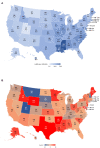Racial and regional disparities of triple negative breast cancer incidence rates in the United States: An analysis of 2011-2019 NPCR and SEER incidence data
- PMID: 36530732
- PMCID: PMC9752091
- DOI: 10.3389/fpubh.2022.1058722
Racial and regional disparities of triple negative breast cancer incidence rates in the United States: An analysis of 2011-2019 NPCR and SEER incidence data
Abstract
Objective: Triple negative breast cancer (TNBC) is a more aggressive subtype resistant to conventional treatments with a poorer prognosis. This study was to update the status of TNBC and the temporal changes of its incidence rate in the US.
Methods: Women diagnosed with breast cancer during 2011-2019 were obtained from the National Program of Cancer Registries (NPCR) and Surveillance, Epidemiology and End Results (SEER) Program SEER*Stat Database which covers the entire population of the US. The TNBC incidence and its temporal trends by race, age, region (state) and disease stage were determined during the period.
Results: A total of 238,848 (or 8.8%) TNBC women were diagnosed during the study period. TNBC occurred disproportionally higher in women of Non-Hispanic Black, younger ages, with cancer at a distant stage or poorly/undifferentiated. The age adjusted incidence rate (AAIR) for TNBC in all races decreased from 14.8 per 100,000 in 2011 to 14.0 in 2019 (annual percentage change (APC) = -0.6, P = 0.024). Incidence rates of TNBC significantly decreased with APCs of -0.8 in Non-Hispanic White women, -1.3 in West and -0.7 in Northeastern regions. Women with TNBC at the age of 35-49, 50-59, and 60-69 years, and the disease at the regional stage displayed significantly decreased trends. Among state levels, Mississippi (20.6) and Louisiana (18.9) had the highest, while Utah (9.1) and Montana (9.6) had the lowest AAIRs in 2019. New Hampshire and Indiana had significant and highest decreases, while Louisiana and Arkansas had significant and largest increases in AAIR. In individual races, TNBC displayed disparities in temporal trends among age groups, regions and disease stages. Surprisingly, Non-Hispanic White and Hispanic TNBC women (0-34 years), and Non-Hispanic Black women (≥70 years) during the entire period, as well as Asian or Pacific Islander women in the South region had increased trends between 2011 and 2017.
Conclusion: Our study demonstrates an overall decreased trend of TNBC incidence in the past decade. Its incidence displayed disparities among races, age groups, regions and disease stages. Special attention is needed for a heavy burden in Non-Hispanic Black and increased trends in certain groups.
Keywords: HER2; SEER; estrogen receptor; incidence; progesterone receptor; racial disparity; temporal trend; triple negative breast cancer.
Copyright © 2022 Zhang, Bai, Sun, Lv and Wang.
Conflict of interest statement
The authors declare that the research was conducted in the absence of any commercial or financial relationships that could be construed as a potential conflict of interest.
Figures






Similar articles
-
State Variation in Racial and Ethnic Disparities in Incidence of Triple-Negative Breast Cancer Among US Women.JAMA Oncol. 2023 May 1;9(5):700-704. doi: 10.1001/jamaoncol.2022.7835. JAMA Oncol. 2023. PMID: 36862439 Free PMC article.
-
Variation in Breast Cancer Subtype Incidence and Distribution by Race/Ethnicity in the United States From 2010 to 2015.JAMA Netw Open. 2020 Oct 1;3(10):e2020303. doi: 10.1001/jamanetworkopen.2020.20303. JAMA Netw Open. 2020. PMID: 33074325 Free PMC article.
-
US incidence of breast cancer subtypes defined by joint hormone receptor and HER2 status.J Natl Cancer Inst. 2014 Apr 28;106(5):dju055. doi: 10.1093/jnci/dju055. J Natl Cancer Inst. 2014. PMID: 24777111 Free PMC article.
-
Racial Disparities in Triple Negative Breast Cancer: A Review of the Role of Biologic and Non-biologic Factors.Front Public Health. 2020 Dec 22;8:576964. doi: 10.3389/fpubh.2020.576964. eCollection 2020. Front Public Health. 2020. PMID: 33415093 Free PMC article. Review.
-
Cancer of the Larynx-20-Year Comparative Survival and Mortality Analysis by Age, Sex, Race, Stage, Grade, Cohort Entry Time-Period, Disease Duration and ICD-O-3 Topographic Primary Sites-Codes C32.0-9: A Systematic Review of 43,103 Cases for Diagnosis Years 1975-2017: (NCI SEER*Stat 8.3.9).J Insur Med. 2024 Jul 1;51(2):92-110. doi: 10.17849/insm-51-2-92-110.1. J Insur Med. 2024. PMID: 39266004
Cited by
-
Immunohistochemistry-based molecular subtyping of triple-negative breast cancer and its prognostic significance.Pathol Oncol Res. 2023 May 19;29:1611162. doi: 10.3389/pore.2023.1611162. eCollection 2023. Pathol Oncol Res. 2023. PMID: 37274773 Free PMC article.
-
Racial/Ethnic Disparities in Pathologic Complete Response and Overall Survival in Patients With Triple-Negative Breast Cancer Treated With Neoadjuvant Chemotherapy.J Clin Oncol. 2024 May 10;42(14):1635-1645. doi: 10.1200/JCO.23.01199. Epub 2024 Feb 23. J Clin Oncol. 2024. PMID: 38394476 Free PMC article.
-
Geographic differences in early-onset breast cancer incidence trends in the USA, 2001-2020, is it time for a geographic risk score?Cancer Causes Control. 2025 Jul;36(7):707-717. doi: 10.1007/s10552-025-01968-7. Epub 2025 Feb 12. Cancer Causes Control. 2025. PMID: 39937364
-
The disparities in prognostic prediction and annualized hazard function in different molecular subtypes between young Chinese and White American women with breast cancer.Front Oncol. 2023 Jul 10;13:1199492. doi: 10.3389/fonc.2023.1199492. eCollection 2023. Front Oncol. 2023. PMID: 37492473 Free PMC article.
-
Racial disparities in outcomes of patients with stage I-III triple-negative breast cancer after adjuvant chemotherapy: a post-hoc analysis of the E5103 randomized trial.Breast Cancer Res Treat. 2024 Jul;206(1):185-193. doi: 10.1007/s10549-024-07308-8. Epub 2024 Apr 23. Breast Cancer Res Treat. 2024. PMID: 38649618 Clinical Trial.
References
-
- Chan WL, Marinho J, Chavarri-Guerra Y, Hincapie-Echeverri J, Velasco RN Jr, Akagunduz B, et al. . Systemic treatment for triple negative breast cancer in older patients: a young international society of geriatric oncology review paper. J Geriatr Oncol. (2022) 13:563–71. 10.1016/j.jgo.2022.01.002 - DOI - PubMed
Publication types
MeSH terms
LinkOut - more resources
Full Text Sources
Research Materials
Miscellaneous

